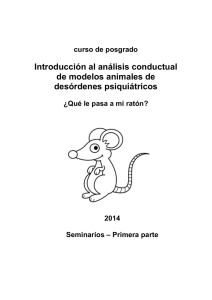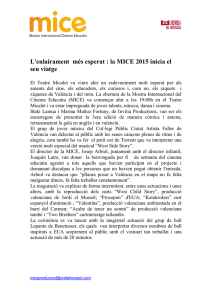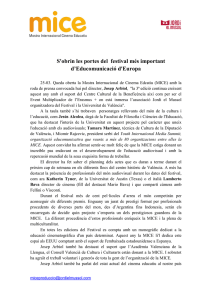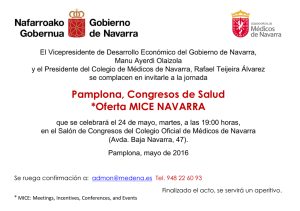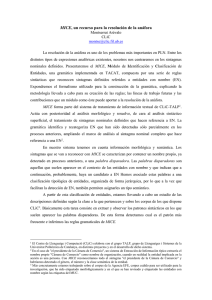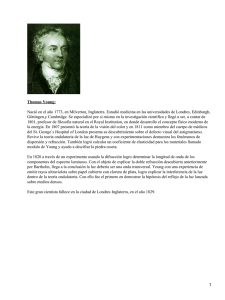Dracula was right: The elixir of youth could be the young
Anuncio
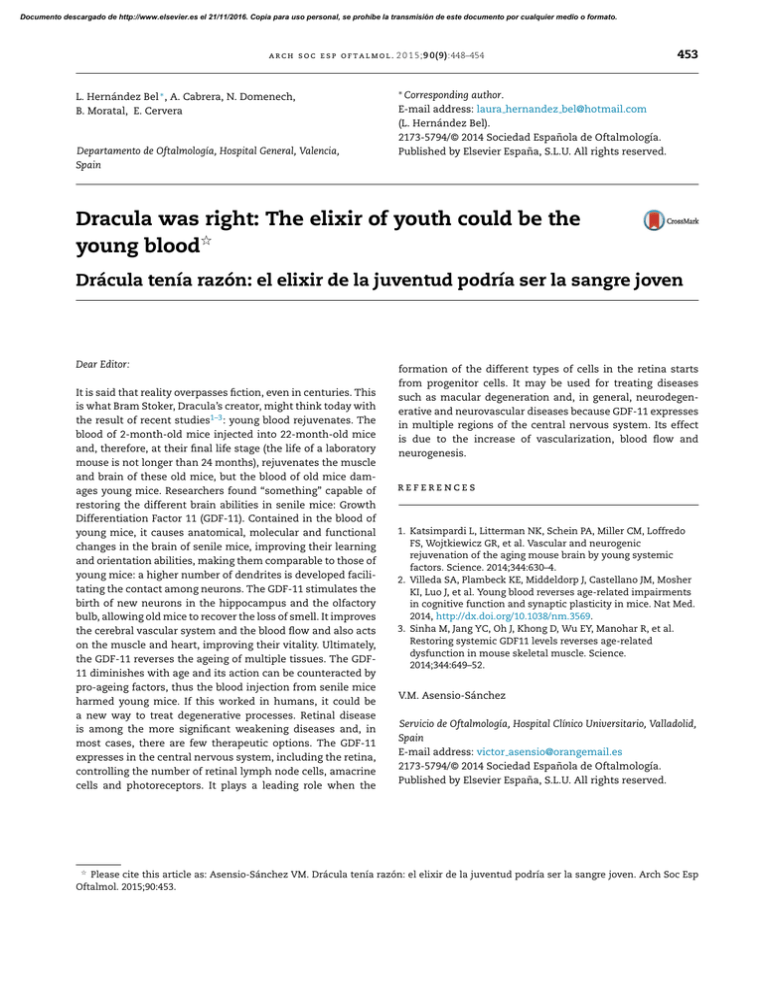
Documento descargado de http://www.elsevier.es el 21/11/2016. Copia para uso personal, se prohíbe la transmisión de este documento por cualquier medio o formato. a r c h s o c e s p o f t a l m o l . 2 0 1 5;9 0(9):448–454 L. Hernández Bel ∗ , A. Cabrera, N. Domenech, B. Moratal, E. Cervera Departamento de Oftalmología, Hospital General, Valencia, Spain 453 ∗ Corresponding author. E-mail address: laura hernandez [email protected] (L. Hernández Bel). 2173-5794/© 2014 Sociedad Española de Oftalmología. Published by Elsevier España, S.L.U. All rights reserved. Dracula was right: The elixir of youth could be the young blood夽 Drácula tenía razón: el elixir de la juventud podría ser la sangre joven Dear Editor: It is said that reality overpasses fiction, even in centuries. This is what Bram Stoker, Dracula’s creator, might think today with the result of recent studies1–3 : young blood rejuvenates. The blood of 2-month-old mice injected into 22-month-old mice and, therefore, at their final life stage (the life of a laboratory mouse is not longer than 24 months), rejuvenates the muscle and brain of these old mice, but the blood of old mice damages young mice. Researchers found “something” capable of restoring the different brain abilities in senile mice: Growth Differentiation Factor 11 (GDF-11). Contained in the blood of young mice, it causes anatomical, molecular and functional changes in the brain of senile mice, improving their learning and orientation abilities, making them comparable to those of young mice: a higher number of dendrites is developed facilitating the contact among neurons. The GDF-11 stimulates the birth of new neurons in the hippocampus and the olfactory bulb, allowing old mice to recover the loss of smell. It improves the cerebral vascular system and the blood flow and also acts on the muscle and heart, improving their vitality. Ultimately, the GDF-11 reverses the ageing of multiple tissues. The GDF11 diminishes with age and its action can be counteracted by pro-ageing factors, thus the blood injection from senile mice harmed young mice. If this worked in humans, it could be a new way to treat degenerative processes. Retinal disease is among the more significant weakening diseases and, in most cases, there are few therapeutic options. The GDF-11 expresses in the central nervous system, including the retina, controlling the number of retinal lymph node cells, amacrine cells and photoreceptors. It plays a leading role when the formation of the different types of cells in the retina starts from progenitor cells. It may be used for treating diseases such as macular degeneration and, in general, neurodegenerative and neurovascular diseases because GDF-11 expresses in multiple regions of the central nervous system. Its effect is due to the increase of vascularization, blood flow and neurogenesis. references 1. Katsimpardi L, Litterman NK, Schein PA, Miller CM, Loffredo FS, Wojtkiewicz GR, et al. Vascular and neurogenic rejuvenation of the aging mouse brain by young systemic factors. Science. 2014;344:630–4. 2. Villeda SA, Plambeck KE, Middeldorp J, Castellano JM, Mosher KI, Luo J, et al. Young blood reverses age-related impairments in cognitive function and synaptic plasticity in mice. Nat Med. 2014, http://dx.doi.org/10.1038/nm.3569. 3. Sinha M, Jang YC, Oh J, Khong D, Wu EY, Manohar R, et al. Restoring systemic GDF11 levels reverses age-related dysfunction in mouse skeletal muscle. Science. 2014;344:649–52. V.M. Asensio-Sánchez Servicio de Oftalmología, Hospital Clínico Universitario, Valladolid, Spain E-mail address: victor [email protected] 2173-5794/© 2014 Sociedad Española de Oftalmología. Published by Elsevier España, S.L.U. All rights reserved. 夽 Please cite this article as: Asensio-Sánchez VM. Drácula tenía razón: el elixir de la juventud podría ser la sangre joven. Arch Soc Esp Oftalmol. 2015;90:453.
